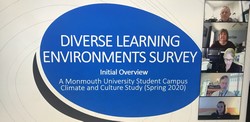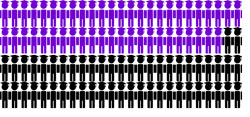A presentation of the campus climate survey results was held on Friday, Oct. 23 to kick off a series of forums titled Moments at Monmouth.
Held virtually this semester, Moments at Monmouth aims to continue campus discussions about anti-racism by affording students and faculty the opportunity to share their experiences, views, and suggestions on Monmouth’s culture of diversity and inclusion, to help the University community become as safe and welcoming as possible.
The campus climate survey was conducted last spring, when President Patrick F. Leahy assigned the President’s Advisory Council on Diversity and Inclusion and the Office of Institutional Research and Effectiveness to conduct a study of our campus culture using national assessment tools.
Leahy sent an email to students inviting them to attend one of the forums as well as the campus climate presentation. “I also invite everyone to attend an open presentation of the student results prior to the Moments at Monmouth sessions,” he wrote. “The candid results of the climate survey show areas where we are doing well, and areas where the need for improvement is clear, but it’s also critically important that everyone in our community is provided the opportunity to share their experiences directly.”
Zaneta Rago-Craft, Ed.D., the Director of the Intercultural Center, introduced the presentation. “We’re just getting into the analysis [of the surveys] and are excited to share with the community what we’re learned.”
Campus climate was defined in the study as employee and student attitudes, actions, and expectations of racism and inclusion as well as institutional policies and procedures. It was then measured by instances of bias and discrimination that students experienced on campus, and their interactions, feelings, and opinions of Monmouth’s commitment to equality and inclusion.
Radek A. Ostrowski, the Director of Assessment for Institutional Research and Effectiveness, briefly went through the initial findings and how to evaluate them in the larger report, which was made available to the Monmouth community in Leahy’s e-vite to the series.
The overall response rate was 15.3 percent, which Ostrowski explained was very good given the length of the survey, on average taking 30 minutes to complete because it was very comprehensive. “The response rate was largely on par with other surveys we’ve seen of this type,” Ostrowski said.
The data should be representative of students’ experiences across the board in terms of class year and the University population in terms of race and ethnicity percentages. However, the results show that first generation students were underrepresented which is important to consider moving forward, Ostrowski noted.
In terms of findings, a sense of belonging is an issue on campus. Overall, 24.8 percent of students do not agree with feeling a sense of belonging on campus and 48.1 percent of respondents have witnessed discrimination but only 10.2 percent have reported it. “We have about two-thirds of our respondents report that they’ve heard insensitive or disparaging remarks, but we have an issue with underreporting of those incidents. This is consistent across all our campus communities, and it’s something we need to look at as an institution,” Ostrowski said.
Retention also strongly correlates to belonging. Out of nearly 50 percent of respondents who considered transferring to another university, nearly a quarter were not registered for the fall semester. This was also seen for the 21.5 percent of students who responded that they may have to choose between financially supporting their family or going to college. “This is a piece that ties into increasing access and affordability at Monmouth,” Ostrowski said. “We’re seeing again that belonging and financial support really play a role in students’ experience and whether they choose to stay at Monmouth.”
In terms of the classroom and learning environment students reported having a consistently positive experience. But, first- and second-year students reported lower scores of curriculum inclusion: the courses that address issues of diversity. “These years are really foundational and if our students are saying that they’re not getting as much access to the types of courses that address these issues, we need to consider that as an institution in how we move forward,” Ostrowski said.
Ostrowski explained that students of color reported higher levels of being singled out in class, feeling they had to work harder than other students, or hearing faculty express stereotypes based on social identity. “These are all things we need to be aware of and areas that we can make a considerable difference in with better understanding of what students are experiencing in the classroom,” he said.
The implications of this survey are to mandate anti-bias training for incoming students, including information on reporting bias. There are also steps that can be taken to improve access to need-based aid for low-income students.
Lastly, to improve classroom climate the core-curriculum requirements can be reexamined to extend cultural diversity and global understanding, as well as create professional opportunities for anti-racism training.
PHOTO TAKEN by Megan Ruggles




